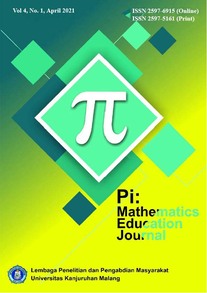STUDENTS’ THINKING PROCESSES IN SOLVING OPEN-ENDED PROBLEMS USING ONLINE LEARNING TAKING INTO ACCOUNT THE MATHEMATICAL ABILITY
Main Article Content
Abstract
It is important for a student to be able to solve problems. This study aims to describe students’ thinking processes in solving open-ended problems with online learning reviewed from mathematical abilities. This research is descriptive in nature with a qualitative approach. The subjects of this research consist of three 8th grade students, while the research instruments that were used consist of a mathematical ability test, an open-ended problem test and interview guideline. The results of the study reveal that student with high mathematical abilities meets all indicators of thinking processes, while student with average mathematical ability at the step of understanding the problem, did not carry out of making arguments, at the step of devising a plan he did not carry out the considering thinking process, as well as did not give an argument at the step of looking back. Almost the same as these results, student with low mathematical ability did not carry out the thinking process of remembering and the process of considering, while at the step of looking back, he did not carry out the process of considering and making an argument. Based on these results, it can be concluded that mathematical ability affects a student’s thinking process.
Downloads
Article Details
Pi: Mathematics Education Journal allows readers to read, download, copy, distribute, print, search, or link to the full texts of its articles and allow readers to use them for any other lawful purpose.

This work is licensed under a Creative Commons Attribution 4.0 International License. The Authors submitting a manuscript do so with the understanding that if accepted for publication, copyright of the article shall be assigned to Pi: Mathematics Education Journal
References
Alwi. 2014. Proses Berpikir Siswa SMP dalam Menyelesaikan Masalah Kesebangunan Bangun Datar Ditinjau dari Perbedaan Kemampuan Matematika. Surabaya: Universitas Negeri Surabaya
Ayu, L.S., Moharom, M.I., Zanthy, L. 2020. “Analisis Kemampuan Berpikir Kreatif Matematis Siswa SMP dalam Menyelesaikan Soal Adopsi ‘PISA.†Jurnal Math Educator Nusantara: Wahana Publikasi Karya Tulis Ilmiah Di Bidang Pendidikan Matematika 7(1): 8–17.
Engle, R. W., Nations, J. K., & Cantor, J. 1990. “Working Memory Capacity Just Another Name for Word Knowledge.†Journal of Educational Psychology 82(4): 799–804.
Fathani, A.H, Ismi, Yuli, I, Nahdiyati, S, Firul. 2020. “Penerapan Group Investigation Untuk Meningkatkan Kemampuan Pemecahan Masalah Kontekstual Bagi Peserta Didik Kelas X SMA Islam Nusantara Malang.†6(1): 1–10.
Firman & Rahayu, S. 2020. “Pembelajaran Online di Tengah Pandemi Covid-19.†Indonesian Journal of Educational Science (IJES) 2(2): 81–89.
Hamzah, A. dan Muhlisrarini. 2013. Perencanaan dan Strategi Pembelajaran Matematika. Jakarta: PT Raja Grafindo Persada.
Handayani, Fitri, U., Sa’dijah, C. & Susanto, H. 2018. “Analisis Kemampuan Berpikir Kreatif Matematis Siswa SMP dalam Menyelesaikan Soal Adopsi ‘PISA.’†Jurnal Math Educator Nusantara: Wahana Publikasi Karya Tulis Ilmiah di Bidang Pendidikan Matematika 4(2):143.
Hartiningrum, Nur, E.S., Maarif, S., & Wijayanti, A. 2020. “Profil Kreativitas Siswa Feminin dalam Menyelesaikan Soal Cerita Matematika Open-ended Berdasarkan Kemampuan Matematika.†Jurnal Ilmiah Soulmath: Jurnal Edukasi Pendidikan Matematika 8(1): 45.
Hewi, L, and Asnawati, L. 2020. “Strategi Pendidik Anak Usia Dini Era Covid-19 dalam Menumbuhkan Kemampuan Berpikir Logis.†Jurnal Obsesi: Jurnal Pendidikan Anak Usia Dini 5(1):158.
Isroil, A., Budayasa, I. K. & Masriyah. 2017. “Profil Berpikir Siswa SMP dalam Menyelesaikan Masalah Matematika Ditinjau dari Kemampuan Matematika.†Jurnal Review Pembelajaran Matematika 2(2): 93–105.
Kemendikbud. 2020. “Kementerian Pendidikan dan Kebudayaan » Republik Indonesia.†Retrieved July 9, 2020. (https://www.kemdikbud.go.id/main/blog/2020/06/panduan-penyelenggaraan-pembelajaran-pada-tahun-ajaran-dan-tahun-akademik-baru-di-masa-covid19).
Lailiyah, E.F. & Lestariningsih. 2018. “Profil Proses Berpikir Siswa dalam Pengajuan Soal (Problem Posing) Ditinjau dari Kemampuan Matematika.†Jurnal Pendidikan Matematika RAFA 4(1): 43–52.
Nizoloman, O.N. 2013. “Relationship between Mathematical Ability and Achievement in Mathematics among Female Secondary School Students in Bayelsa State Nigeria.†Procedia - Social and Behavioral Sciences 106:2230–40.
Polya, G. 1973. How to Solve It (A New Aspect of Mathematical Method). New Jersey: Princeton University Press.
Santrock, J.W. 2018. Educational Psychology; 6th Edition. New York: McGraw-Hill Companies.
Setianingsih, R. 2013. “Proses Berpikir Siswa dengan Kecerdasan Linguistik dan Logis Matematis dalam Memecahkan Masalah Matematika.†Jurnal Mathedunesa 3(2):1–8.
Siswono, T. Y. E. 2008. Model Pembelajaran Matematika Berbasis Pengajuan dan Pemecahan Masalah untuk Meningkatkan Kemampuan Berpikir Kreatif. Surabaya: Unesa University Press.
Siswono, T. Y. E. 2018. Pembelajaran Matematika Berbasis Pengajuan dan Pemecahan Masalah. Bandung: Remaja Rosdakarya.
Slavin, R. E. 2006. Educational Psychology: Theory and Practice (8th Edition). Boston: Pearson Education, Inc.
Sternberg, R.J. 2008. Psikologi Kognitif. Edisi Kedelapan. Edisi Bahasa Indonesia. Penerjemah: Yudi Santoso, S.Fil. Yogyakarta: Pustaka Pelajar.
Sumarmo, U. 2010. “Berpikir dan Disposisi Matematik: Apa, Mengapa, dan Bagaimana Dikembangkan pada Peserta Didik.†FPMIPA UPI 1–27.
Wibowo, K. 2016. Defragmenting Struktur Berpikir Pseudo dalam Memecahkan Masalah Matematika. Yogyakarta: Deepublish.

